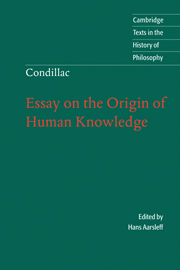Book contents
- Frontmatter
- Contents
- Acknowledgments
- List of abbreviations
- Introduction
- Chronology
- Further reading
- Note on the text and translation
- Essay on the Origin of Human Knowledge
- Introduction
- PART I The materials of our knowledge and especially the operations of the soul
- Section 1
- Section 2 Analysis and generation of the operations of the soul
- Section 3 Simple and complex ideas
- Section 4
- Section 5 Abstractions
- Section 6 Some judgments that have been erroneously attributed to the mind, or the solution of a metaphysical problem
- PART II Language and method
- Index
- Cambridge texts in the history of philosophy
Section 3 - Simple and complex ideas
Published online by Cambridge University Press: 05 June 2012
- Frontmatter
- Contents
- Acknowledgments
- List of abbreviations
- Introduction
- Chronology
- Further reading
- Note on the text and translation
- Essay on the Origin of Human Knowledge
- Introduction
- PART I The materials of our knowledge and especially the operations of the soul
- Section 1
- Section 2 Analysis and generation of the operations of the soul
- Section 3 Simple and complex ideas
- Section 4
- Section 5 Abstractions
- Section 6 Some judgments that have been erroneously attributed to the mind, or the solution of a metaphysical problem
- PART II Language and method
- Index
- Cambridge texts in the history of philosophy
Summary
§ A complex idea is the union or the collection of several perceptions; a simple idea is a perception considered distinct by itself.
Though the qualities that affect our senses (says Locke [E 2.2.1]) are so firmly united and so well blended together in the things themselves that there is no separation or distance between them, it is nonetheless certain that the ideas which these different qualities produce in the mind enter it by the senses in a manner that is simple and without any blending. For though sight and touch do often at the same time excite different ideas from the same object, as when someone sees motion and color simultaneously or when the hand feels the softness and warmth in a piece of wax, the simple ideas which are thus united in the same subject are as perfectly distinct as those that enter the mind by different senses. The coldness and hardness that we feel in a piece of ice are ideas that are just as distinct in the mind as the smell and whiteness of a lily or as the taste of sugar and the smell of a rose; nothing can be more evident to any man than the clear and distinct perception he has of those simple ideas, of which each taken separately is altogether uncompounded, consequently producing nothing in the mind but an entirely uniform conception that is not distinguishable into different ideas.
- Type
- Chapter
- Information
- Condillac: Essay on the Origin of Human Knowledge , pp. 71 - 77Publisher: Cambridge University PressPrint publication year: 2001



